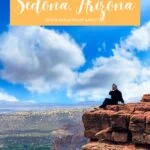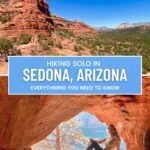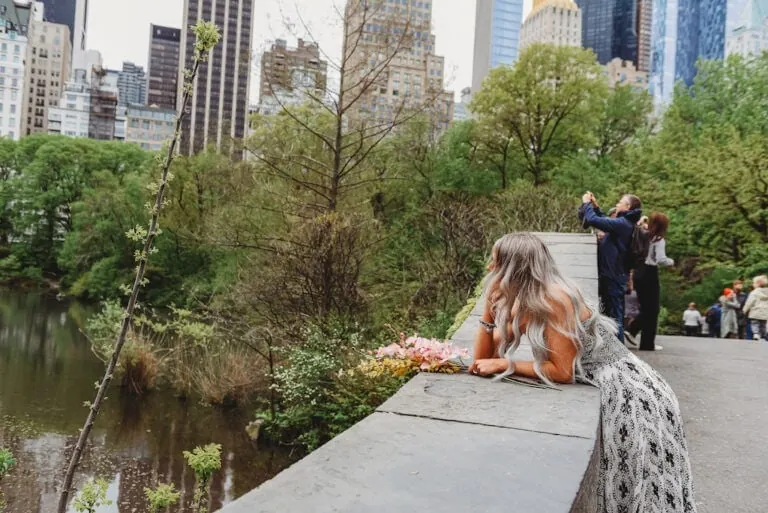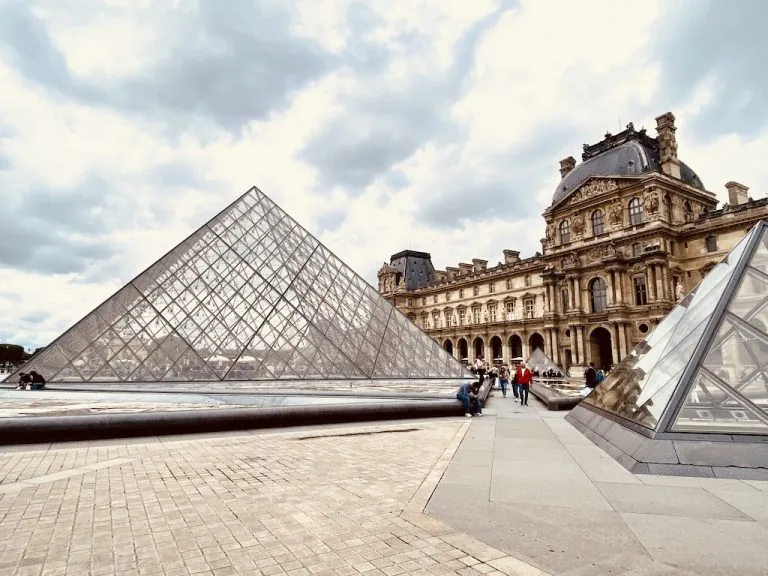This post may contain affiliate links that I earn a small commission from at no cost to you. I only promote products, makeup, and clothing brands that I love and use in real life. When you purchase through my affiliate links, it helps me to continue doing what I love, which is helping you learn the best things about the places I travel!
Let me start with the obvious: going hiking alone gets a bad rap. According to the National Park Service, anywhere from 120-150 people die from hiking each year, and the chances are obviously increased if you’re by yourself. But as someone who loves to travel solo, I know that I can do juuust about anything alone…as long as I’m smart about it. This blog post is about how and why I feel safe going hiking alone in Sedona, AZ, the measures I take in order to feel that way, and how you can feel safe too.
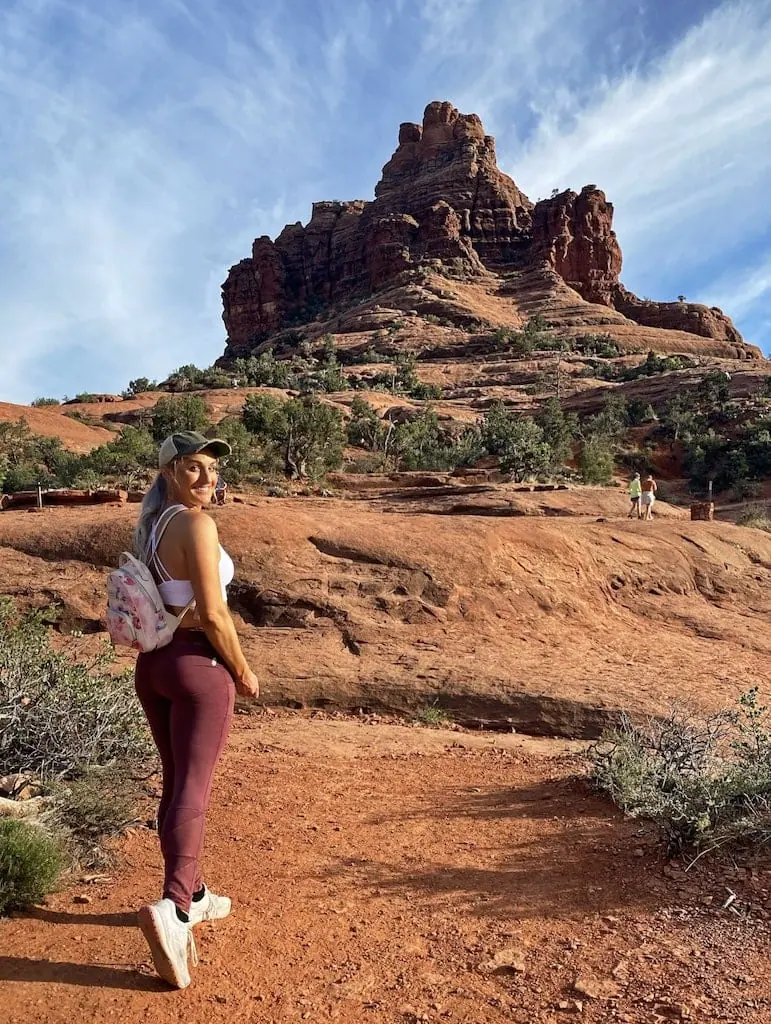
Read More of my Favorite Posts About
Sedona, Arizona
Is It Safe to Hike Alone in Sedona?
Overall, my answer would be YES – as long as you are prepared!
The following is my “mental checklist” of things that I do before leaving for a solo hike in Sedona:
- I share my location with my friends and let them know which hike(s) I am doing that day
- I make sure to pack all my hiking essentials, along with at least one protein bar or snack
- I download my AllTrails map to my phone in case I don’t have service on the trail
- I preview the route to get an idea of how strenuous the hike will be and how long it will take me. The longer the hike, the more food/water I bring.
What is the Most Common Reason for Deaths during Hiking?
When hiking deaths occur, the most common reason people die is from falling, followed closely by element exposure to extreme climates.
Hiking Deaths from Falling
Deaths from falls while hiking are usually caused by sustaining some sort of traumatic brain injury (TBI). It’s important to have things like good hiking shoes and hiking poles to lessen your chances of something happening.
The majority of trails that I have hiked in Sedona don’t involve risky climbs where I felt like I could fall and hit my head. The only times I have felt a little frightened are when I was climbing up a steep ledge to get into a hidden cave, but even still, I felt the chances of me falling and hitting my head were slim.
Hiking Deaths from Elemental Exposure
Sedona is in the desert, which means temperatures can get especially hot in the summertime. When I went here in June, the highs were in the mid 90’s throughout most of the afternoon.
In Sedona, many people have died from extreme dehydration during the summer months. I brought this water bottle with me because it holds 40 ounces of water and isn’t overly bulky. I also made sure to start the majority of my hikes between 6:00-7:00 am to avoid the extreme temperatures.
- If you want a more intense backpack/water bottle combo, click here!
I’ve also heard stories of people venturing off the beaten path of the trail to explore other parts of the surrounding area, getting lost, and dying from starvation/element exposure. I really like using AllTrails because the interactive maps help me avoid getting lost, even if I were to take a wrong turn.
- Pro Tip: Some trails in Sedona don’t have cell service; don’t forget to download the maps for your hikes to your phone, just in case.
Being Smart About Hiking Solo
During my last trip to Sedona, I really wanted to hike Bear Mountain Trail because it had a hidden cave that not many people knew about (but was supposedly beautiful!). After looking on AllTrails, I saw where this trail was rated as “hard” due to a rocky terrain and almost 2,000 feet of elevation gain. 2,000 feet may not sound like much to more experienced hikers, but when it’s 90+ degrees out, I wanted zero parts of that.
There was also not a route to this “mystery cave” listed on AllTrails. I had read a few other travel blogs that tried to explain how to get to it, but I thought the directions were somewhat unclear and didn’t trust myself to be able to find it.
I fought with myself all week: “should I just tryyyy to find it and turn around if it’s too hard?” vs. “no, this is stupid to do by yourself!” In the end, my logical brain won, and I didn’t go. The elevation + the heat + the lack of direction for an already directionally challenged person is a recipe for disaster. Don’t get me wrong though…it’s still on my list of hikes to eventually do, and when it happens, I’ll make sure you can read about it 😘.
Why I Feel Safe Hiking Alone in Sedona
With the exception of my very first Sedona trip, I have done all of my hikes solo. The reason I’m not afraid is because I know that Sedona is a very popular hiking destination, and a lot of the trails I choose are very popular. In other words, I know I’m not going to be the only one on the trail.
Even on trails like Boynton Canyon and Soldiers Pass that have hidden caves, I have encountered at least one other person going off the beaten path to try and find these hidden gems. AllTrails also has maps specifically devoted to these 2 caves in particular, so I felt safe knowing that I had a GPS to guide me.
In fact, I have met many people on hiking trails that I have ended up walking with, sitting on rocks and chatting with, and even going to dinner & drinks with afterward! (“Wait, you mean like a date??” … Yes, a date. You’ll read about it one day 😉.)
Snakes, Scorpions, and Spiders, Oh My!
In addition to falling and extreme temperatures like I mentioned earlier, you also have to be prepared for the wildlife. Thankfully, the largest animal I saw during my hikes were lizards, but I know there are rattlesnakes, tarantulas, scorpions, and coyotes that live in the Sedona mountains.
Out of all of these things, my biggest worry was a rattlesnake. I always YouTube what sound a rattlesnake makes before I fly to Sedona so I have it in my head to listen for. IMO, it sounds more like maracas shaking than it does an actual “rattle,” but whatever. The point is, I know what to watch and listen for!
- Pro Tip: The pharmacist in me also knows that anti-venom drugs work really, really well should I ever need them. Oh, you didn’t know I went to pharmacy school before I became a blogger? Check out my About Me section to read my full story here!
Hiking in the Spring/Fall vs. Hiking in the Summer or Winter
If you want to hike Sedona in the summer months, I hope you are a morning person. The hottest month in Sedona is July, and the average temperature can get up in the 100’s. Like I mentioned above, you need to start your hike between 6:00-7:00am.
I have hiked in Sedona during the spring (April) and the summer (June). As you can imagine, I saw a lot more people hiking in the spring due to the cooler temperatures. There were a few trails in the summer where I only saw one or two other people, but the routes of the trails were straightforward so I didn’t feel concerned. I also had plenty of water and made sure to hydrate throughout the rest of the day.
I’ve never hiked in the fall, but I can imagine the temperatures are similar to spring and you’d see a lot more hikers around this time. Sedona can actually get pretty chilly in the winter, with average temperatures in the 50s. The lows can drop to high 20’s/low 30’s though, and the last thing I want to do is carry a massive blanket with me up a rocky terrain in case I get lost. In other words, you will not catch me hiking here in the winter months!
Summary – Hiking Alone in Sedona, AZ
Overall, I feel confident going hiking alone in Sedona. I know I will see other people on the trails, I bring plenty of water and snacks, and I always make sure my AllTrails maps are downloaded to my phone.
The key to solo travel is being prepared, and having a plan in the back of your mind if something were to go wrong. As long as you’re smart about it, you should feel safe embarking on your solo hiking adventure!


